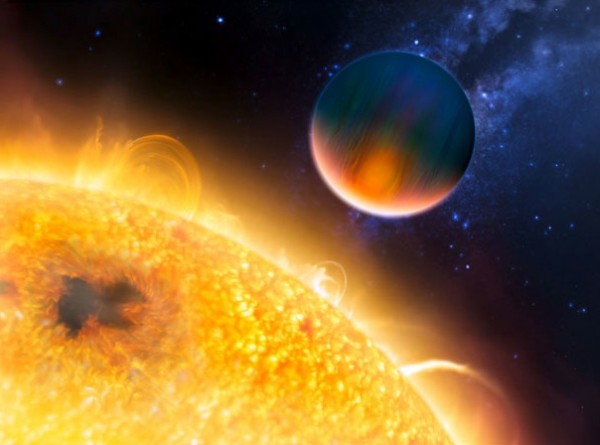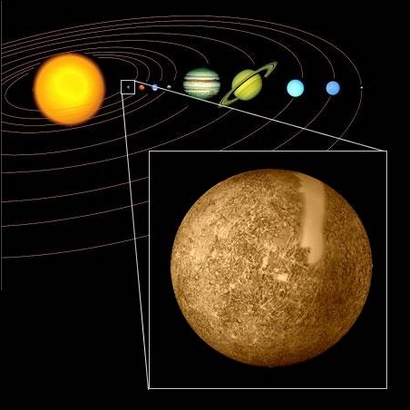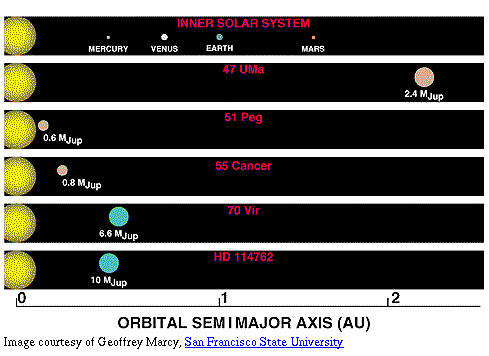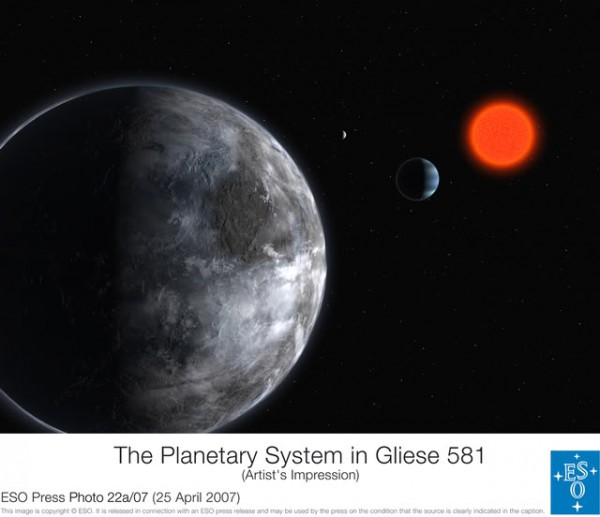"We are all captives of the pictures in our head -- our belief that the world we have experienced is the world that really exists." -Walter Lippmann
For a long time, humans have wondered about life on other worlds, and about worlds around other stars. Until the 1990s, this was mostly speculation and hope. But shortly thereafter, some clues started rolling in. In 1992, the first planet outside of our Solar System was detected, and three years later, the first planet around a solar-like star was found.

Only, something was awfully weird about this planet. You see, in our Solar System, Mercury is the closest planet to the Sun. Mercury takes 88 days to orbit the Sun, lives (on average) 58 million km from the Sun, and is very light, weighing only 5.5% as much as the Earth. And that's what we're used to -- for an innermost planet -- thanks to our Solar System.

So you can imagine the surprise when Bellerophon -- or 51 Pegasi b -- was announced. Instead of 88 days, it orbited its star in just 4.2 days, located a mere 7 million km from the stellar surface, and weighing in at over 150 times the mass of Earth!
When the next few extra-solar planets were discovered, they looked a lot more like this nightmarish world than like any of the ones orbiting our star. They were massive giant planets, located far closer to their stars than any of our gas giants are, and in many cases, far closer to their star than even the Earth is!

So what gives? Well, these "hot Jupiters" aren't very common at all. The reason we found so many of them, it turns out, is that these are the easiest planets to find.
And we've gotten a lot better over time. As of this past Monday, the extra-solar planet catalogue had compiled 461 planets orbiting other stars!

And while most of them were still comparable to the size of Jupiter or Saturn, many of them were starting to get smaller, including a few rocky planets. (Including in the Gliese 581 system, above.)
Well, that's all about to change. There's the NASA Kepler mission, which is currently monitoring a small patch of the sky, looking at about 100,000 stars.
That's all that Kepler is doing, mind you. By monitoring these same stars, accurately, from space, over a long period of time, they're likely to discover many, many planets! How? Every so often, one of these planets will pass in front of its star, blocking just a little bit of its starlight. As this happens, periodically, we can figure out the size and distance of the planet from its star!

And, wouldn't you know, earlier this week the Kepler team released their first results. (Steinn and Nancy have some good things to say about it, too.)
What did they find? Let's put up the planets in our Solar System for you to look at while I spill the beans.

They have found, definitely, 306 new extra-solar planets, including 5 systems with multiple planets. Unlike previous searches, most of the planets that Kepler found are Neptune-sized (the smallest gas giant in our Solar System) or smaller!
That's very, very promising! But they've left us with the ultimate teaser: they are withholding data -- for a year -- on 400 particularly juicy candidates!
What did they find? Are they Earth-sized planets? Are they planets in the habitable zones around their stars? Are they "just barely" detections, and they want to get some more data?
If we assume that each one is a planet, that brings us to 706 planets around 100,000 stars. Since our galaxy has around 200 billion stars, we can figure out that there ought to be -- wait for it -- at least 1.4 billion planets in our galaxy!
And that, mind you, is a lower limit, as this only will see planets orbiting edge-on to their stars! But it's the biggest lower limit we've ever been able to set, and you're among the first to know!

I ⥠Kepler SO MUCH.
I have several questions and observations:
Q1: Do most planets obit their stars in the same plane as the galactic plan that incorporates them?
Q2: If the answer to Q1 is true, then wouldn't it be difficult to see the planet occultation of the star due to the dust within a galaxy if the galaxy is edge-on to us (including our own galaxy)?
Q3: If the answer to Q1 is true, then galaxies that we see from the 'north' or 'south' would not let us see planets transverse their stars because we would see their entire orbit for 'above'.
Observation: Even given possible yes answers to these three questions, then the Kepler results would only be a fraction of even more possible planets than 706/100,000
So if even one in a thousand planets has life on it... Whew...
Of all the planets that have life on them, and among those of them that have evolved spacefaring species, I wonder how many have heads less bumpy than ours.
This really makes you think. Imagine if the earth were as big as Jupiter. Think of all the frequent flier miles you would have.
We can't see individual stars in other galaxies, so your Q2 and Q3 are not applicable.
Do we have any idea what percentage of planetary systems we'd be viewing edge-on, and thus, what percentage of total planets that 1.3 billion estimate represents? Because, that would surely be a rather small percentage, it seems to me!
NewEnglandBob:
Probably not. Ours certainly does not. (This is why you can only see the Magellanic Clouds from the southern hemisphere.)
@NewEnglandBob
Yeah, Ethan mentioned that this was simply a lower limit. Not only are we missing planets outside orbital planes, but certainly tons of long period planets. This data is for a 33.5 day observation. So we can get an estimate on how many 10+ year period planets are out there based on how many we see and how long we were looking. Amazing stuff.
"But it's the biggest lower limit we've ever been able to set, and you're among the first to know"
I've been waiting a couple of days for this story to spread like wildfire, but apparently at least 306 new extrasolar planets being discovered isn't that big a story. Bigger surprises to come in February, I guess.
I thought that these 706 planets or so were only the first 40days of observations, so by wouldnt it be logical to infer for the 100000 stars that there would be many more we just need more time for the data to come back?? or is kepler looking at many many more then 100000 stars within its field
cheers
To be fair, they do caution that maybe 50% of these 306 are false positives of some kind: these are candidate planets.
Still, it's a lot.
It is, as the english say, somewhat of a huge deal.
Considering the expected false positive rate of 50 %, that lower limit is more like 0.7 Gstars. Still a lot!
@ NEB:
I don't think Q1 is true. The orbital plane, if there isn't too much planetary migration disturbing it, should be set by the of the rotation protoplanetary nebula. That in turn is decided by the sum of angular momentum of a shrinking turbulent dust nebula. How would that mess couple to a galactic plane?
And indeed, I believe observation has it that star rotation is scattered all over the place?!
@ LWF:
? How do you figure that?
@ cn78:
IIRC some 2-4 % of the orbiting systems was estimated to show transits. (Presumably depending on how close and how big the planets are, to sufficiently block the primary.)
@ Lee:
I saw a commenter elsewhere note that this may be the bulk of the finds, as the likelihood of detection drops for farther out planets. I don't know if "the bulk" part is true though.
"by the of the rotation protoplanetary nebula" - by the of the rotation of the protoplanetary nebula.
The phrase that Carl Sagan often used, "billions and billions" come to mind here. To further put things into perspective:
"Who are we? We find that we live on an insignificant planet of a humdrum star lost in a galaxy tucked away in some forgotten corner of a universe in which there are far more galaxies than people." - Carl Sagan
We can even now safely project that there's far more planets out there than galaxies or perhaps even stars, but as to the actual number of "people" the good doctor was apparently referring only to our own local group since countless planets would equate to a countless potential for the development of extra terrestrial intelligence.
If Mars was once a wet planet as we recently seem to have proven, it's a pretty safe bet that the same factors that ultimately generated life on our own planet must have once had a pretty good chance to have done the same on Mars. Mars is the "red planet" because of iron oxide, so quick, calculate how much oxygen is now bound in those surface sediments and imagine how much of it was once part of the atmosphere there and whether much of it could be again.
Fascinating stuff. Following on from Lloyd's comment, and from everything else we've discovered about the potential for life elsewhere in the universe, it looks increasingly likely that the answer to the Fermi Paradox is that high-tech, energy-rich industrial civilisation, if it ever occurs, is just the briefest blip in a planet's history, and that no miraculous, inexhaustible supplies of energy are ever discovered. Perhaps other planets have fossil fuels, like ours, and their first intelligent species rapidly burns through all the easily-accessible stuff, as we have done, and then are doomed to an equally rapid and painful collapse back to a post-industrial energy-poor state. No shiny fleets of spacecraft plying their solar systems and beyond for thousands and millions of years, no vast radio dishes beaming out the collective wisdom of their species to the rest of the universe. If they're out there, maybe only one or less would be likely to be a detectable source of radio emissions during the time that we have the capacity to detect them. We would have to be pretty lucky to find it.
Q1)How does the end equation account for planets that aren't big enough/close enough to the star to give a detectable "tug".
Q2)How does it account for solar systems that are not side on to us? (As in the planet does not pass between us and it's star)
Surely it is fairly premature to calculate an estimate of planets in the solar system.... Stars are SOOOO far apart and their light dominates their solar system, I'm pretty sure we won't get a good "estimate" for the average solar system for many decades/centuries.
Don't get me wrong though, this is an exciting find.
#14, Lloyd so far is the only one sniffing along the most logical path.
Look for an iron-cored star and then seek out iron enriched inner planets.
Those planets forum under unusual conditions and that skews the probability curves for finding life elsewhere.
"We are all captives of the pictures in our head -- our belief that the world we have experienced is the world that really exists." -Walter Lippmann
What is the difference between "the world", "the world that exists", and "the world that really exists"? There is no difference. And some people are *not* captives of the pictures in their head, but, by utilizing their intellect, are able to go beyond those limitations. Sometimes Walter Lippmann was one of those people, but not regarding the quote above.
Nothing to add here except that I love this blog.
Steve #16:
The post states that this is a *lower estimate*, that is, that there are at least that many planets. It doesn't pretend to be an accurate estimate, and the truth is likely to be MUCH bigger.
Q2)How does it account for solar systems that are not side on to us? (As in the planet does not pass between us and it's star)
It doesn't. See comment #12 where it's stated that it's estimated that only 2-4% of systems could be detected by this method.
So, the truth will surely be much greater. After all, we're only able to observe 1 in 25-50 of systems, and planets further from their sun are more likely to be missed (as well as requiring more time to observe, since it can only be observed at one point in its orbit). There may well be hundreds of billions of planets out there!
At the other extreme, back in January, Kepler scientist Geoff Marcy of the University of California at Berkeley said he believed that at least â70 percent of all stars have rocky planets.â
hello i say whats up1ghujew
NEED MORE CHOCOLATE
junk crapy blog
how many planets are there
I want to know the number of solar systems discovered. and can the sun be called a sun?
How do you do a projet about sun ,Earth and Moon !!!!!!!!!?
Is it hard or easy?????????????
Last week i heard from a professor that there has been a new planet in the solar system.I want a confirmation whether it is true.
Is it true that there are people under ground
bkit b merong planets ?
I think 306 planets are a very small number ,so I think 306 planets have to be only be given for a galaxy
I think there are
My name is Yahya Hayatu Sanusi, I am a Student at Zaria Children School, GRA Zaria. who ever see should please know that he will help me with the list of the additional types of Planets; thatnk you as you help me. YAHYA HAYATU SANUSI
Wow there is a lot of planets in this universe
How did you find that many...
please how can i get the names of the newly found planets and stuffs about them.
if there is a site i can be referred to please help me out
@Jackson Evans #36: Wikipedia, "List of exoplanets."